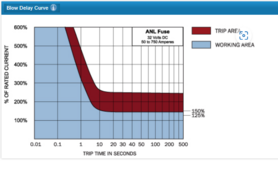It looks like the winch is 12 volt vs 24 volt and will be running off of the 12 volt starter battery system, supplemented by the dual 24 - 12 volt dc converters ?
No, I'm sorry it isn't more clear. The 12V Lynx which will fuse the lift, the liftgate, the fusebox etc.... will get its supply of 12V either from the paired Orions.... OR from the truck battery/alternator as a back up if my 24V system crashes. So obviously all the 12V items are fused at the 12V Lynx.
The alternator will always be connected to the 12 volt starter batteries to keep it from blowing out if switched / disconnected while running.
No, the alternator and truck battery are intended to never be used for the 12V needs unless their is a failure on the 24V side of things. The winch by the way will no longer be on the 12V lynx, all my research really shows that has the potential to suck way to much current... Also, its an item for the more distant future anyway, I have not installed it yet in the floor of the truck.
I guess I would be tempted to feed the dual 24 - 12 volt Orion power supplies from the 24 volt lynx to the 12 volt lynx to protect things on both sides. That would tend to keep them from blowing out or over straining the battery pack if that is a concern.
Well, yes, as I described, each of the Orion's would have say a 40 amp fuse coming off my 24V Lynx distributor.... 24V x 40 amps is 960 watts. If each can put out 80 watts max at 12 Volts, thats the same watts.
In order to get 2400 watts from the inverter, you will need the 3000 / 24, as that is a 2400 watt inverter. Maybe that is what you have, I cannot read the label on my screen that well.
In the text of my post, I say that I have the 24/2000. It is capable of at most 4000 watts output. Thats a little over 160 amps, I can't EVER imagine pulling that much out of the inverter. Hence the 150 amp fuse I think is reasonable
I don't understand the purpose of the red switch.
Yes, I see that. It allows an emergency back up for my 12V needs. It would NOT power up the inverter in any fashion. Switch it between the paired Orion's output, or the truck battery/alternator set up.
You will probably want to add a breaker such as this one in between the 12 volt lynx and the fuse block so you can easily shut off the power to do simple changes.
Thats a good idea, or really just a switch, its fused at the Lynx so I don't need protection, just cut-off.
Thermal circuit breakers provide heavy duty circuit protection for 25 to 200 Amp loads when switching and circuit protection are both required.

www.bluesea.com
I will be honest, I don't see what the lynx is doing for you vs using a conventional bus bar and adding a few more of the 187 breakers, but I know that people like to have blue colors in their power systems.
Funny you mention that. I have bought two of the Power In modules that look like Lynx. You are correct, there is no need for a true Lynx distributor for MANY of us. But I've adapted mine to be fused with good hardware, and bought 12 and 24V LED so that I can actually light up the devices when there is power going through, and the fuse is intact. Will be slick, and the lynx power in serves as a very compact busbar and fuse box for both (+) and (-) buss. Its elegant.
As far as the fuse or breaker that you use coming off of the 24 volt lynx or a similar bus bar to feed the orions, I would use the same rating as you are using for the other items, such as the solar charge controller to make your life easy to buy / stock spares. 50 - 60 amps and just use at least 6 awg wire.
I haven't gotten to adding solar yet... budget restrictions. Frankly the truck isn't insulated yet even, so the solar and AC are longer term plans. So I haven't actually considered yet what fuse I will need for the MPPT. I chose a Victron 150/60 TR model based on its ability to handle the planned PV array... but I'm still not really sure what to fuse that at going to the 24V buss/Lynx
____________
@chrisski is correct that you need to also fuse or breaker the 12 volt side. Suppose there is a short to ground in the wire on the 12 volt side of one of those wires from the orion. There will be a very large path to ground for a lot of 12 volt and it will not shut off on it's own.
The two obvious ways to do this are to either use a breaker or feed it through a fused spot on the 12 volt lynx.
I'll have to consider this more closely. The run of wire between the Orion output and the 12V Lynx will be inches. Not feet. Hard to see how that would get grounded accidentally. But given that I'm moving the Winch over to the truck, I think that does open up space on the 12V Lynx to fuse the input 12V, ie the output of the Orions. Thanks.



